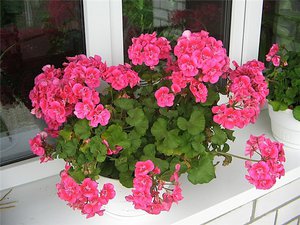If you turn to specialized literature, you can find out that royal pelargonium is also known under a number of other names - royal geranium, large-flowered pelargonium. For scientists, the more familiar name of the plant sounds like - Regal Pelargonium, Pelargonium grandiflorum. Pelargonium is a member of the Geraniaceae family and can grow up to 25-50 cm in height.
However, this plant is best known as an indoor flower, which can be explained by its long flowering period and unpretentious care. Reproduction of royal pelargonium is simple and effective, since cuttings are most often used for it.
Content
Characteristics and description of the flower
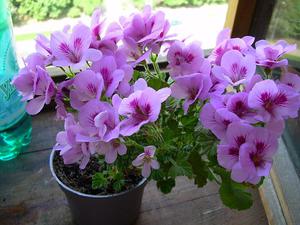 Until the middle of the 18th century, Europe was unfamiliar with geraniums, however, everything changed when the first samples of this plant were brought from South Africa. It became the basis for breeding new varieties from cuttings.
Until the middle of the 18th century, Europe was unfamiliar with geraniums, however, everything changed when the first samples of this plant were brought from South Africa. It became the basis for breeding new varieties from cuttings.
Along with other species, breeders managed to create Pelargonium royal large-flowered, the main decoration of which is their large flowers.
- These plants usually grow as compact shrubs, which are mostly hybrids. When grown at home, they come in the form of small, dense bushes and fragile, highly branching stems.
- Depending on the variety, pelargonium can have different shapes and sizes of leaves. Petioles of geraniums do not differ in length from leaf blades. Many varieties of pelargonium grow round leaves decorated with slightly lobed edges.
- Geranium flowers grow on an elongated, thin stem, which is covered with spherical umbrellas. It often has single, large-sized flowers with bright colors.
- The cultivated variety of pelargonium affects the color of the flowers, which can be white or have any shade of pink and red.
- When grown indoors, you can get fairly low-growing pelargoniums, which do not exceed 25-50 cm in height. The upper part of the leaves is serrated and has a rough texture, and the edges have a sharp wavy shape.
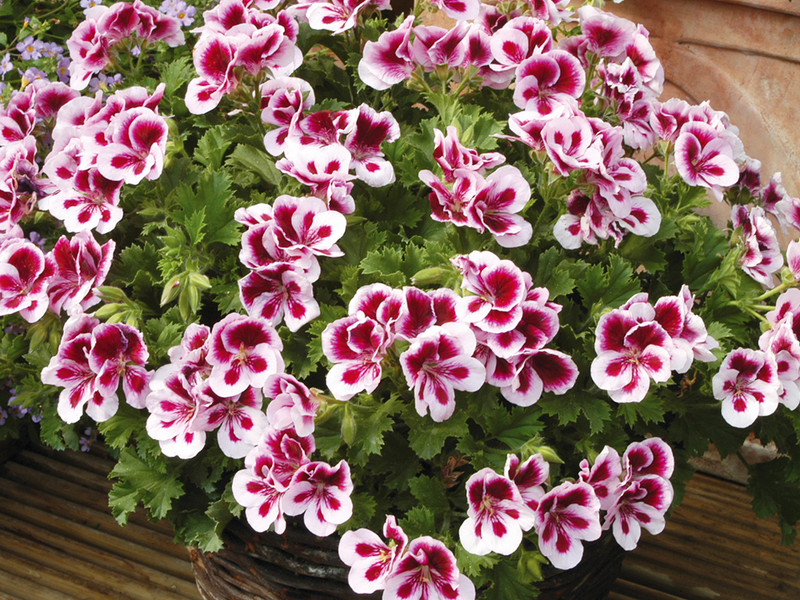
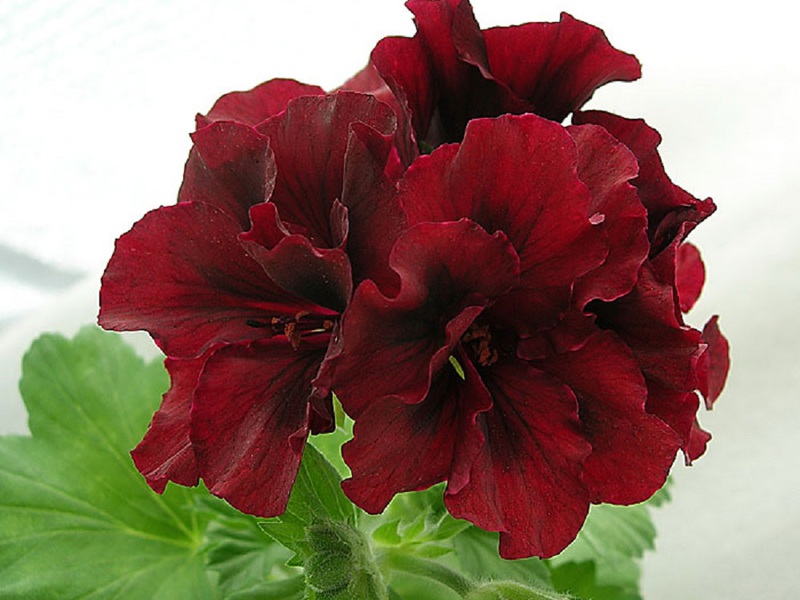

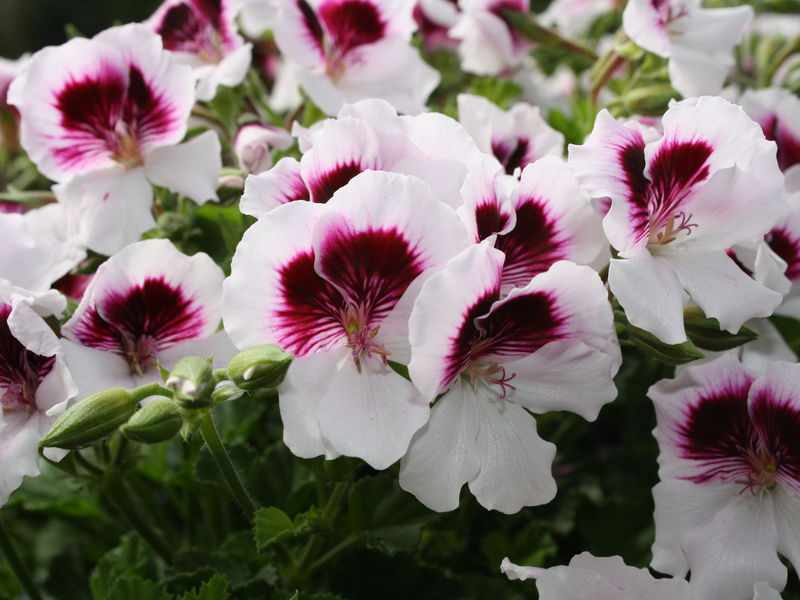
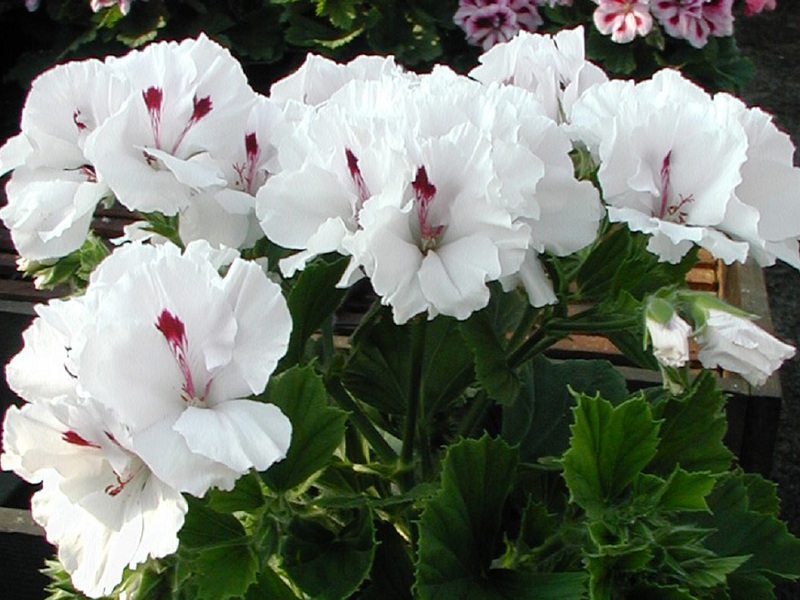

Flowers are different simple, funnel-shaped, reaching a diameter of 5-8 cm. At the ends of the stems or young branches grow about 10 flowers, which look like a cone.
The petals usually have a darker shade in the inner region, often in their front dark lines are formed... With proper plant care, you can enjoy pelargonium flowers from early spring to late summer.
Care features
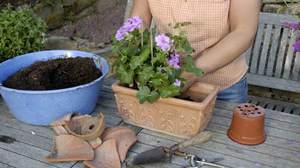 When growing royal pelargonium at home, it is necessary to create favorable conditions for it, without which it is impossible to ensure its normal development.
When growing royal pelargonium at home, it is necessary to create favorable conditions for it, without which it is impossible to ensure its normal development.
This plant feels most comfortable in the lungs, air spaces... Individual owners are not limited to growing geraniums at home.If necessary, they can be planted in a garden, on a balcony or on a terrace sheltered from precipitation.
Often they are installed on the windowsill. But in this case, you have to take care of creating good ventilation, since the plant needs not only an optimal temperature regime, but also air humidity.
In general, in terms of illumination, geranium has the following basic requirements:
- Providing maximum illumination, in summer, partial shading is required.
- If the plant is grown outside the home, then in the chosen place it is necessary to make a shelter from precipitation.
- It is imperative to provide protection from direct sunlight.
- In winter, pelargonium should be grown in a lighted and cool place, where a low temperature is maintained - no higher than 10-14 degrees Celsius. In this case, she will be able to form bud ovaries.
Watering royal geranium
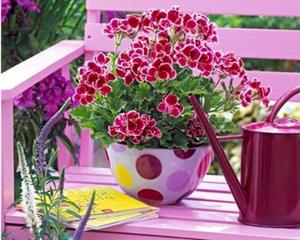 For the normal growth of royal pelargonium, you need to provide regular and correct watering... In summer, it should be done twice a day - in the morning (at about 10 o'clock) and in the evenings when the sun sets. In winter, watering the plant once a day is enough.
For the normal growth of royal pelargonium, you need to provide regular and correct watering... In summer, it should be done twice a day - in the morning (at about 10 o'clock) and in the evenings when the sun sets. In winter, watering the plant once a day is enough.
Certain features are available when caring for royal pelargonium hybrids. Since they are more accustomed to an elevated temperature compared to zonal geraniums, they slightly increase the water consumption during irrigation.
When watering adult bushes, they adhere to the scheme - no more than 50 ml at a time. The amount of water consumed should be sufficient so that the soil can be slightly wetted.
Should avoid excess moisture, since in such conditions, the likelihood of rot and infection increases. This often explains the reluctance of royal pelargonium to bloom at home.
Required temperature
When growing royal pelargonium, it is necessary ensure optimal temperature within the range of 18-25 degrees Celsius.
It is not recommended for the temperature to exceed the specified threshold. Also, some damage can be caused to the plant by drafts, heaters, a sharp cold snap.
To avoid these unpleasant situations, it does not hurt every florist to have a hygrometer, thermometer and weather station.
Plant sleep period
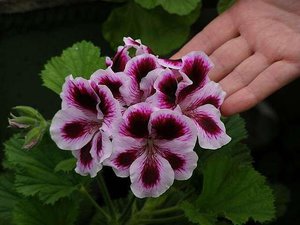 In the dormant stage, which lasts for royal pelargonium from October to March, it is necessary to prevent the earthen coma from drying out. The very same care at this time of the year, the plant is almost not required.
In the dormant stage, which lasts for royal pelargonium from October to March, it is necessary to prevent the earthen coma from drying out. The very same care at this time of the year, the plant is almost not required.
Even before pelargonium enters the resting stage, you need cut off the flowers on it, buds and weak leaves. When pruning, you must remove the shoots one third of the length.
Such a measure not only gives the plant more freedom, but also helps it get more air. Another advantage of pruning is the increased resistance to diseases and pests. Watering should be carried out only at those moments when it is required, taking into account the situation.
In the resting stage, royal pelargonium is grown at a temperature of 15 degrees Celsius. However, it may be difficult for individual growers to properly care for the plant in winter due to lack of space or time to do so. In this case, proceed as follows:
- the plants are removed from the pots, then the leading shoots are shortened, the root ball is cleaned of dirt, and the roots are also cut off;
- at this stage of the life cycle, each plant is wrapped in newspaper and wrapped in foil;
- in the end, it remains to tie and hang it in the basement.
This method will undoubtedly appeal to many, since throughout the winter no need to care for the flower... Pelargonium is remembered in March when it is taken out of the package and transplanted back into the pots.
Geranium pruning and fertilization
 During the entire growing season, once every two weeks, it is necessary to apply liquid fertilizers... From October to February, the plants are dormant, so feeding is not required at this time of year.
During the entire growing season, once every two weeks, it is necessary to apply liquid fertilizers... From October to February, the plants are dormant, so feeding is not required at this time of year.
Once again, I want to repeat that the compact bushes of royal pelargonium bloom most abundantly in comparison with the overgrown ones. New branches are often formed in old, already lignified shoots.
If geranium has been grown for many years, then pruning once a year is enough for it. And the time does not matter.
How geraniums reproduce
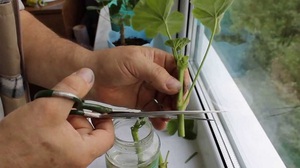 Regardless of the variety of royal pelargonium, from which you want to get a new bush at home, it is recommended use the grafting method... To do this, you need to prepare cuttings in the first weeks of summer or in autumn, which are cut below the internodes at an angle of 45 degrees.
Regardless of the variety of royal pelargonium, from which you want to get a new bush at home, it is recommended use the grafting method... To do this, you need to prepare cuttings in the first weeks of summer or in autumn, which are cut below the internodes at an angle of 45 degrees.
If the shoot belongs to a dwarf variety, then it must be separated by about 5 cm, and for large ones - 10 cm. Having ready cuttings on your hands, you need to cut off the lower leaves and flowers from them.
The process of reproduction of flowers of royal geranium at home takes place in a slightly different pattern than in the case of other varieties. It is not recommended to allow increased soil moisture, as this can lead to plant decay.
For this reason, you should be very careful with the cuttings: when there are several days left before planting, you should refrain from placing them in water.
A more effective measure is to dry them for two hours. However, first you need a cut point charcoal and "Kornevina".
To get new geranium bushes at home, you first have to prepare small pot... As drainage, you can use the shards that fill the bottom of the pot.
Further, a soil mixture based on peat and sand, taken in equal quantities, is placed in a pot and watered thoroughly. Then the harvested cuttings are planted.
It is not recommended to plant the cutting in wet or excessively dry soil, therefore, in such a situation, immediately after planting, watering can only be carried out along the edge.
What to do after landing
The popularity of the royal geranium cuttings method can be explained by the fact that the harvested shoots take root quickly. Usually 3-4 weeks are enough for the first shoots to appear. This is a sure sign that it's time to increase your watering a little.
However, here you need be as careful as possibleas there is a danger of soaking the substrate.
When 4 more weeks have passed, young royal pelargonium bushes begin harden in the sun, and subsequently care for them is carried out in the same way as for adult specimens.
After waiting for the formation of a well-developed root system in them, you can transplant geraniums into the soil, which is prepared from compost.
Pelargonium transplant
 Even against the backdrop of the appearance of many flowers and leaves, the royal geranium itself often remains quite compact. The resulting root shoots look for additional growth space in the drainage hole, and when they succeed, they clog it.
Even against the backdrop of the appearance of many flowers and leaves, the royal geranium itself often remains quite compact. The resulting root shoots look for additional growth space in the drainage hole, and when they succeed, they clog it.
This is one of the common reasons why pelargonium does not bloom at home. In relation to geraniums, transplantation can be carried out no more than once every two years, using a fresh earthen substrate.
First, you need to clean the rhizome from the old soil by shaking gently. Further, pruning of long, thick roots and shoots is carried out in order to remove part of them by half. Then the geraniums are returned to the old pot, which was previously fill with fresh soil.
It is recommended to transplant in the spring, although, if necessary, it is allowed to do this at any time during the growing season of royal pelargonium.
Pests and care errors
 The greatest danger to the royal geranium is the disease "blackleg". It can be determined by the fact that the stems are painted black at ground level.But you need to be very careful, as this disease can quickly affect the entire plant.
The greatest danger to the royal geranium is the disease "blackleg". It can be determined by the fact that the stems are painted black at ground level.But you need to be very careful, as this disease can quickly affect the entire plant.
It usually occurs due to waterlogged soil or high humidity. To prevent this from happening, for royal pelargonium it is necessary create optimal conditions development, and they imply the provision of relatively dry air.
Rust is also a problem for geraniums. The harm from it is manifested in the yellowing of the leaves and their subsequent death. Geranium shoots and flowers are not protected from this disease.
Therefore, upon noticing potential signs of rust on the leaves of a flower, they immediately need to cut off, which is an effective preventive measure against this ailment.
Royal pelargonium for many does not sound very familiar, although this should not be surprising, because this is the official name of geranium.
A rather beautiful plant is hidden under it, which can become a spectacular decoration not only in an apartment, but also in a garden area. However, proper care of her requires creation of favorable conditions for growth, otherwise it will not even be easy to wait for the flowering of pelargonium.


